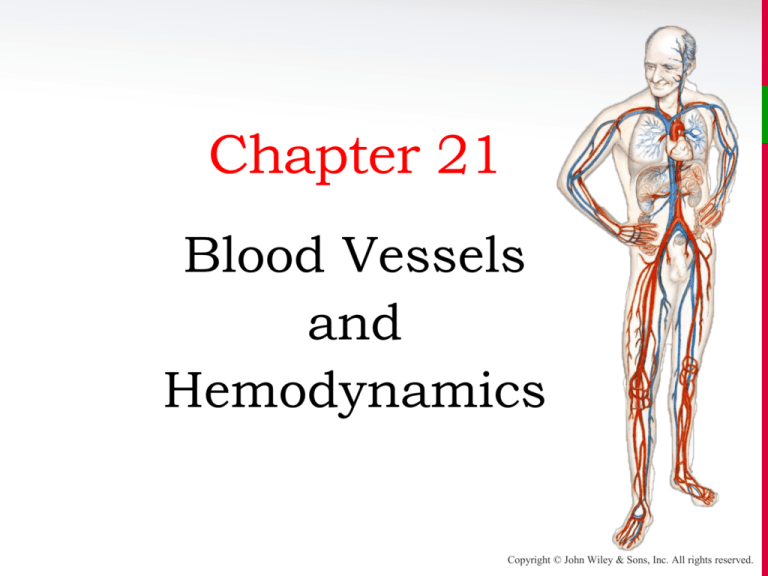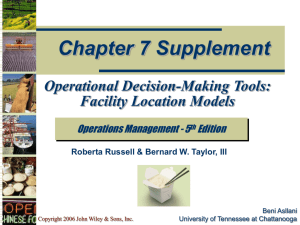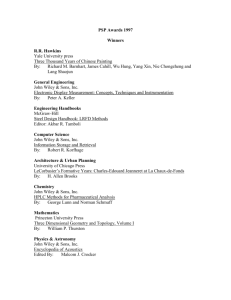
Chapter 21
Blood Vessels
and
Hemodynamics
Copyright © John Wiley & Sons, Inc. All rights reserved.
Circulatory Routes
Blood vessels are organized into circulatory routes that
carry blood to specific parts of the body.
• The pulmonary circulation leaves the right heart to
allow blood to be re-oxygenated and to off-load CO2.
• The systemic circulation leaves the left side of the heart
to supply the coronary, cerebral, renal, digestive and
hepatic circulations (among others).
•
Copyright © John Wiley & Sons, Inc. All rights reserved.
Copyright © John Wiley & Sons, Inc. All rights reserved.
Systemic Circulation
- Arteries
Copyright © John Wiley & Sons, Inc. All rights reserved.
Branches of ascending aorta
Right and left Coronary
arteries
Copyright © John Wiley & Sons, Inc. All rights reserved.
Branches of arch of aorta
•Brachiocephalic trunk
•Right common carotid artery
•Right subclavian
•Left common carotid artery
• Left subclavian artery
Copyright © John Wiley & Sons, Inc. All rights reserved.
Systemic Circulation - Arteries
Copyright © John Wiley & Sons, Inc. All rights reserved.
Internal carotid
Vertebral artery
External carotid
Common carotid
Copyright © John Wiley & Sons, Inc. All rights reserved.
Superficial
temporal
Branches of external
carotid A.
Facial artery
Copyright © John Wiley & Sons, Inc. All rights reserved.
Copyright © John Wiley & Sons, Inc. All rights reserved.
Circle Of Willis: an arterial anastomosis between the
branches of internal carotid and vertebral arteries
Copyright © John Wiley & Sons, Inc. All rights reserved.
Subclavian
Axillary
Brachial
Radial artery
Ulnar artery
Copyright © John Wiley & Sons, Inc. All rights reserved.
Systemic
Circulation
- Arteries
Copyright © John Wiley & Sons, Inc. All rights reserved.
Posterior intercostal
arteries- branches of
thoracic aorta
Anterior intercostal arteries:
most arise from internal
mammary artery (internal
thoracic artery) which is a
branch of subclavian artery
Copyright © John Wiley & Sons, Inc. All rights reserved.
Branches of abdominal aorta
•Celiac trunk ( unpaired)
•Common hepatic artery
•Left gastric artery
•Splenic artery
•Superior mesenteric artery (unpaired)
•Renal arteries (paired)
•Gonadal arteries (testicular/ovarian) paired
•Inferior mesenteric artery (unpaired)
•At L4 level, aorta bifurcates into the two Common
iliac arteries
Copyright © John Wiley & Sons, Inc. All rights reserved.
Systemic Circulation - Arteries
Copyright © John Wiley & Sons, Inc. All rights reserved.
Transverse colon of
large intestine
Superior mesenteric
Inferior mesenteric
Abdominal aorta
Common iliac
Descending colon of
large intestine
Superior mesenteric A. supplies small intestines and proximal large intestine
Sigmoid colon
Inferior mesenteric A. supplies rest of large intestine
Rectum of large
intestine
(c) Anterior view of inferior mesenteric artery and its branches
Copyright © John Wiley & Sons, Inc. All rights reserved.
Copyright © John Wiley & Sons, Inc. All rights reserved.
Systemic Circulation
- Veins
Copyright © John Wiley & Sons, Inc. All rights reserved.
Systemic Circulation - Veins
Copyright © John Wiley & Sons, Inc. All rights reserved.
Copyright © John Wiley & Sons, Inc. All rights reserved.
The Internal jugular drains venous blood from the brain and
Subclavian vein drains the upper limb, both join to form the
Brachiocephalic vein
Rt. & Lt. Brachiocephalic veins join to form
SVC
Copyright © John Wiley & Sons, Inc. All rights reserved.
Systemic Circulation - Veins
Copyright © John Wiley & Sons, Inc. All rights reserved.
Right and left Common Iliac veins join
to form the IVC
Copyright © John Wiley & Sons, Inc. All rights reserved.
Systemic Circulation - Veins
Copyright © John Wiley & Sons, Inc. All rights reserved.
Copyright © John Wiley & Sons, Inc. All rights reserved.
Hepatic Portal Circulation
The hepatic portal system is designed to take nutrient- rich
venous blood from the digestive tract & blood from spleen,
and transport it to the sinusoidal capillaries of the liver.
(A vein that carries blood from one capillary network to
another capillary network is called a portal vein)
• As it percolates through the liver sinusoids, the hepatocytes
extract and add what they wish to maintain homeostasis
• extracting glucose, fats, proteins when appropriate and then
dumping them back into the circulation when necessary
Copyright © John Wiley & Sons, Inc. All rights reserved.
Hepatic Portal Circulation
The inferior mesenteric vein drains into the splenic vein
The superior mesenteric and splenic vein unite to form the
hepatic portal vein.
The liver is receiving nutrient-rich but deoxy- genated blood
via the hepatic portal vein ( it is also receiving oxygenated
blood via the hepatic artery- a branch of celiac trunk).
The blood mixes in sinusoids of liver
Eventually, blood leaves the sinusoids of the liver through the
hepatic veins, which drain into the inferior vena cava.
Copyright © John Wiley & Sons, Inc. All rights reserved.
Hepatic veins draining into
IVC
Splenic vein
Hepatic portal vein
Superior
mesenteric vein
Inferior mesenteric
vein
Hepatic Portal Circulation
Copyright © John Wiley & Sons, Inc. All rights reserved.
Hepatic Portal Circulation
Inferior mesenteric vein
Copyright © John Wiley & Sons, Inc. All rights reserved.
Fetal Circulation
The fetus has special circulatory requirements because their
lungs, kidneys and GI tract are non-functional.
The fetus derives its oxygen and
nutrients and eliminates wastes
through the maternal blood supply
by way of the placenta
Normally, there is no maternal/fetal mixing
Copyright © John Wiley & Sons, Inc. All rights reserved.
Fetal Circulation
Oxygenated blood leaves the placenta through the
umbilical vein. It then bypasses the liver via the ductus
venosus and dumps into the inferior vena cava en route
to the right heart.
This oxygen-rich blood then
bypasses the lungs by
traveling to the left heart
through the foramen ovale.
Copyright © John Wiley & Sons, Inc. All rights reserved.
Fetal Circulation
Blood remaining in the right heart is diverted into the
aorta by-passing the lungs
through the ductus
arteriosus
returning
to the placenta via the
umbilical arteries.
Copyright © John Wiley & Sons, Inc. All rights reserved.
Fetal circulation (before birth)
Copyright © John Wiley & Sons, Inc. All rights reserved.
Neonatal Circulation After Birth
At birth, the neonate’s lungs open and in just a few
seconds, there is a massive drop in pulmonary vascular
resistance.
• Blood now entering the right heart now flows to the
low pressure lungs and has no “incentive” to flow
through the foremen ovale or the ductus arteriosus.
Another change also occurs very rapidly - the umbilical
cord is severed.
• And so begins the adult pattern of blood flow.
Copyright © John Wiley & Sons, Inc. All rights reserved.
Neonatal Circulation After Birth
Within hours, days, or weeks after birth, the umbilical
vein atrophies to become the ligamentum teres.
• The ductus venosus atrophies to become the
ligamentum venosum.
• The foramen ovale becomes the closed fossa ovale.
• The ductus arteriosus atrophies to become the
ligamentum arteriosum.
• Umbilical arteries atrophy to become the medial
umbilical ligaments.
Copyright © John Wiley & Sons, Inc. All rights reserved.
Neonatal Circulation After Birth
Copyright © John Wiley & Sons, Inc. All rights reserved.







